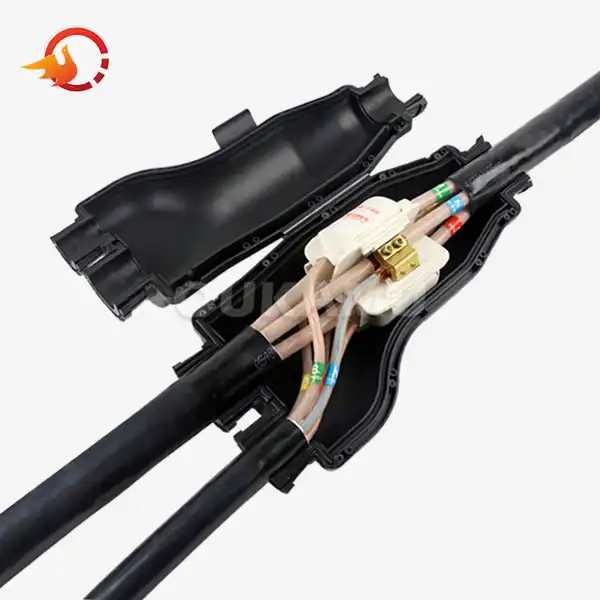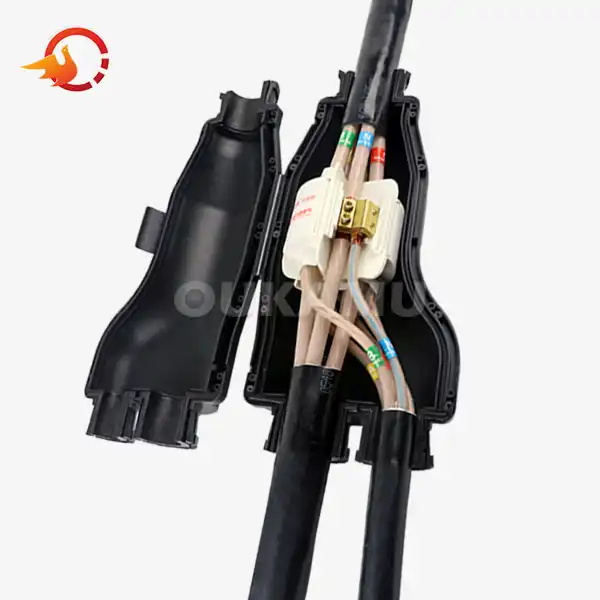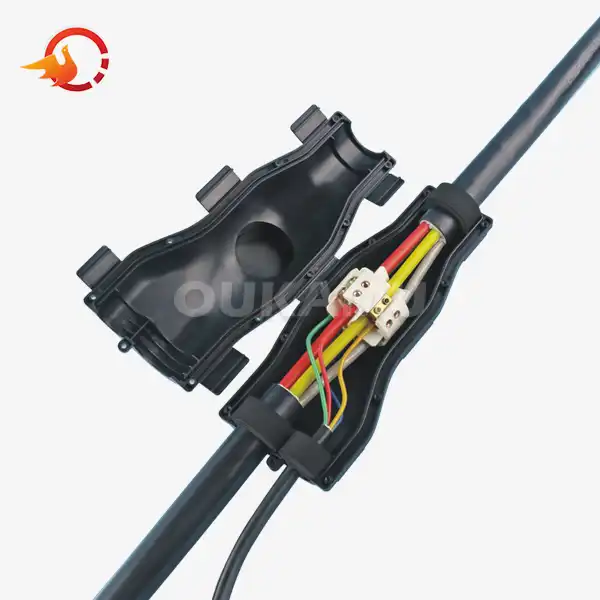The Complete Guide to Branch Wiring for Residential Projects
 2025-09-01 11:43:52
View:389
2025-09-01 11:43:52
View:389Cable Branch Connectors is a crucial component of any residential electrical system, providing power to various outlets and appliances throughout your home. Understanding the intricacies of branch wiring is essential for homeowners, electricians, and DIY enthusiasts alike. In this comprehensive guide, we'll explore the essential components, installation tips, and optimization strategies for branch wiring in residential projects.
Essential Components of Residential Branch Wiring
Before diving into the installation process, it's crucial to familiarize yourself with the key components of branch wiring. These elements work together to ensure a safe and efficient electrical system in your home.
Circuit Breakers and Panels
The heart of your branch wiring system is the electrical panel, which houses circuit breakers. These devices protect your home from electrical overloads and short circuits. OUKAMU, a leading manufacturer of electrical components, offers high-quality circuit breakers designed for optimal performance and safety.
Conductors and Cables
Conductors are the wires that carry electricity throughout your home. They come in various gauges and types, depending on the specific application. Non-metallic (NM) cables, such as Romex, are commonly used in residential branch wiring. These cables typically contain multiple conductors wrapped in a protective sheath.
Outlets and Switches
Outlets and switches are the points where you interact with your electrical system. They come in various configurations to meet different needs, such as standard receptacles, GFCI outlets, and dimmer switches.
Junction Boxes
Junction boxes provide a safe enclosure for wire connections and splices. They're essential for maintaining the integrity of your electrical system and complying with building codes.
Cable Branch Connectors
Cable branch connectors, like those produced by OUKAMU, allow for efficient and safe branching of electrical circuits. These innovative devices simplify the process of creating T-connections and can significantly reduce installation time and complexity.
Step-by-Step Branch Wiring Installation Tips
Now that we've covered the essential components, let's explore the process of installing branch wiring in a residential setting.
Planning and Design
Before starting any electrical work, it's crucial to create a detailed plan of your branch wiring system. Consider the following factors:
- Load requirements for each room and appliance
- Circuit layout and distribution
- Local electrical codes and regulations
- Future expansion needs
Safety First
Electrical work can be hazardous if proper precautions aren't taken. Always follow these safety guidelines:
- Turn off power at the main breaker before starting work
- Use appropriate personal protective equipment (PPE)
- Double-check all connections with a multimeter
- Never work on live circuits
Running Cables
When running cables for your branch circuits, consider these tips:
- Use cable staples to secure NM cables to wooden studs and joists
- Drill holes in studs and joists as needed, following local code requirements for hole size and placement
- Leave enough slack at each end for connections
- Protect cables from damage by using nail plates where necessary
Making Connections
Proper connections are crucial for a safe and reliable electrical system. Follow these guidelines:
- Strip wire insulation carefully, avoiding nicks in the conductor
- Use appropriate wire nuts or lever nuts for connections
- Ensure all connections are tight and secure
- Use OUKAMU cable branch connectors for T-connections to simplify the process and improve reliability
Installing Devices
When installing outlets, switches, and other devices:
- Follow manufacturer instructions for wiring diagrams
- Use the correct size of electrical box for the number of conductors
- Secure devices firmly to electrical boxes
- Ensure proper grounding of all devices
Testing and Verification
After completing the installation:
- Use a circuit tester to verify proper wiring of outlets and switches
- Check for continuity and proper grounding
- Test GFCI and AFCI devices to ensure they're functioning correctly
- Verify that all circuit breakers are properly sized and labeled
Optimizing Branch Wiring for Safety and Efficiency
To ensure your branch wiring system operates at peak performance, consider these optimization strategies:
Load Balancing
Distribute electrical loads evenly across multiple circuits to prevent overloading and improve overall system efficiency. This may involve:
- Dedicating circuits for high-draw appliances like refrigerators and air conditioners
- Splitting lighting and receptacle loads across different circuits
- Using OUKAMU cable branch connectors to create flexible circuit configurations
Voltage Drop Mitigation
Voltage drop can occur in long branch circuits, reducing the efficiency of connected devices. To mitigate this issue:
- Use larger gauge wires for long runs
- Install subpanels closer to areas with high electrical demand
- Consider using OUKAMU's innovative cable branching solutions to optimize circuit layouts
GFCI and AFCI Protection
Enhance safety by implementing Ground Fault Circuit Interrupter (GFCI) and Arc Fault Circuit Interrupter (AFCI) protection:
- Install GFCI outlets in wet locations such as kitchens, bathrooms, and outdoor areas
- Use AFCI breakers or outlets in bedrooms and living areas to protect against arc faults
- Consider whole-house GFCI and AFCI protection for maximum safety
Regular Maintenance and Inspections
To ensure the longevity and safety of your branch wiring system:
- Conduct annual visual inspections of visible wiring and devices
- Test GFCI and AFCI devices monthly
- Schedule professional electrical inspections every 3-5 years
- Replace outdated or damaged components promptly
Future-Proofing Your Electrical System
As technology evolves, so do our electrical needs. Consider these strategies for future-proofing your branch wiring:
- Install additional circuits and outlets to accommodate future growth
- Use conduit in some areas to allow for easy cable upgrades
- Implement a structured wiring system for data and communication needs
- Consider the potential for electric vehicle charging when planning your electrical system
Conclusion
Branch wiring is a critical aspect of any residential electrical system, and understanding its components, installation process, and optimization strategies is essential for creating a safe and efficient home. By following the guidelines outlined in this guide and utilizing innovative products like OUKAMU's cable branch connectors, you can ensure your electrical system meets current needs while being prepared for future demands.
Remember, while many aspects of branch wiring can be understood by homeowners, it's crucial to consult with or hire a licensed electrician for complex installations or when unsure about any electrical work. Safety should always be the top priority when dealing with electrical systems. For more information about cable connection products and innovative solutions for your branch wiring needs, please contact OUKAMU at info@okmbranchcable.com.
FAQ
Q1: What is the difference between a branch circuit and a feeder circuit?
A1: A branch circuit is the final portion of an electrical circuit that supplies power directly to outlets and fixtures. A feeder circuit, on the other hand, supplies power to other distribution points or subpanels within the electrical system.
Q2: How many outlets can I have on a 20-amp circuit?
A2: While there's no specific limit, a general rule of thumb is to have no more than 10 outlets on a 20-amp circuit. However, this can vary based on the expected load and local electrical codes.
Q3: What are the advantages of using OUKAMU cable branch connectors?
A3: OUKAMU cable branch connectors offer several benefits, including simplified T-connections, reduced installation time, improved reliability, and greater flexibility in circuit design.
Q4: How often should I have my home's electrical system inspected?
A4: It's recommended to have a professional inspection every 3-5 years, or more frequently for older homes or if you notice any electrical issues.
Q5: Can I do my own branch wiring installation?
A5: While some minor electrical work can be done by homeowners, complex branch wiring installations should be performed by licensed electricians to ensure safety and code compliance.
References
1. National Electrical Code (NEC) Handbook, 2020 Edition. National Fire Protection Association.
2. Holzman, H. N. (2019). Residential Wiring: A Practical Guide to Electrical Installations. McGraw-Hill Education.
3. Cauldwell, R. (2017). Wiring a House: 5th Edition. Taunton Press.
4. Black & Decker (2017). The Complete Guide to Wiring, Updated 7th Edition. Cool Springs Press.
5. Shapiro, D. (2018). Your Old Wiring: A Complete Guide to Rewiring Your Home. McGraw-Hill Education.















